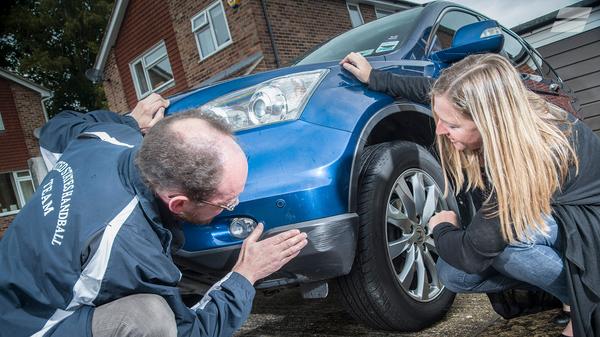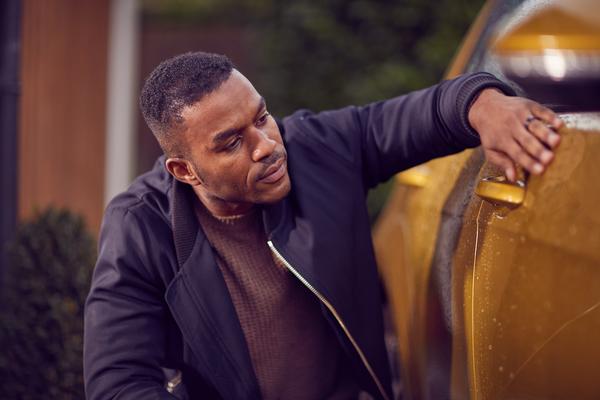Advice
Check a used car for damage or signs of accident
Buying a used car requires thorough checks and inspection so that you know exactly what you’re paying for. Here are our tips and advice on what to check before buying a used car, and questions you should be asking the car dealer.


Words by: Nimisha Jain
Last updated on 22 January 2021 | 0 min read
Unlike an approved used car, where most of the inspections are done for you, buying a used car is not always as simple.
Before you commit to buying a used car, you should arrange a viewing to inspect its condition, look for faults, and ensure that the car matches the description. Outside the car, you should check parts like the body, paint, lights and tyres. Inspecting the inside of the car may require more time and effort with several elements requiring your attention like the mileage, seats, steering, airbag, boot, bonnet, windows and air conditioning, to name a few.
Before you commit to buying a used car, you should arrange a viewing to inspect its condition, look for faults, and ensure that the car matches the description. Outside the car, you should check parts like the body, paint, lights and tyres. Inspecting the inside of the car may require more time and effort with several elements requiring your attention like the mileage, seats, steering, airbag, boot, bonnet, windows and air conditioning, to name a few.
A used car has had repairs, should I be worried?
If you notice that a car has gone through some repairs, you don’t necessarily have to worry. You should check the repairs have been done properly though. Ask to see the service log book, or arrange a vehicle check to confirm key details such as whether the vehicle is a write-off, whether it has outstanding finance, the number of previous owners and other important factors.
To help make this step in your car buying journey easier, we’ve listed down a set of used car checks that you should do before committing to the car. If you’re thinking of getting a used car inspection done from a professional, you can check out our advice.
To help make this step in your car buying journey easier, we’ve listed down a set of used car checks that you should do before committing to the car. If you’re thinking of getting a used car inspection done from a professional, you can check out our advice.
Used car exterior checklist
• Check for any damage to the body such as scratches, dents and so on.
• Look for uneven gaps between the panels. If the gap looks too narrow or wide, it could indicate poor repairs or damage from an accident. Compare one side of the car with the other to ensure that the panel gaps are even. • The paintwork should be an even colour all over the car. If it’s not, it could be a sign of extensive repairs and re-sprayed panels. If any of the paintwork is bubbling up, be wary as this could be a sign of rust. • Check that the lights and indicators work properly and that there’s no damage to the lenses such as fogged lenses or uneven beams. • Make sure the roof is in good condition, especially if you’re considering a convertible. Keep an eye out for any tears in a soft top and check that it all operates smoothly. • Check that all four tyres are in good condition, they have enough tread on them and that they match the mentioned specifications. You can check that very simply with the edge of a coin: insert a 20p coin into the grooves of the tyre – if the outer band is covered, the tyre is legal. • Make sure any wear on the tyres is even across the entire tread. If it’s not, this could be a sign of something wrong with the suspension. • Check the car sills and wheel arches for salt, grime and sand as they can rust the surface. • If the tyres are fitted with locking wheel nuts, then make sure you get the special adapter required, and it fits. • As a last test, push down each corner of the car. If all’s well with the suspension, the car will bounce back up again nice and smoothly.
• Look for uneven gaps between the panels. If the gap looks too narrow or wide, it could indicate poor repairs or damage from an accident. Compare one side of the car with the other to ensure that the panel gaps are even. • The paintwork should be an even colour all over the car. If it’s not, it could be a sign of extensive repairs and re-sprayed panels. If any of the paintwork is bubbling up, be wary as this could be a sign of rust. • Check that the lights and indicators work properly and that there’s no damage to the lenses such as fogged lenses or uneven beams. • Make sure the roof is in good condition, especially if you’re considering a convertible. Keep an eye out for any tears in a soft top and check that it all operates smoothly. • Check that all four tyres are in good condition, they have enough tread on them and that they match the mentioned specifications. You can check that very simply with the edge of a coin: insert a 20p coin into the grooves of the tyre – if the outer band is covered, the tyre is legal. • Make sure any wear on the tyres is even across the entire tread. If it’s not, this could be a sign of something wrong with the suspension. • Check the car sills and wheel arches for salt, grime and sand as they can rust the surface. • If the tyres are fitted with locking wheel nuts, then make sure you get the special adapter required, and it fits. • As a last test, push down each corner of the car. If all’s well with the suspension, the car will bounce back up again nice and smoothly.

Used car interior checklist
• Check that the mileage is consistent with what you’re promised.
• Compare the wear in the car to the miles on the clock. If the odometer says low miles, but there's peeling plastic on the steering wheel or gear lever, worn-out pedal rubbers and frayed fabric on the seats, it can be an indication of high miles. • Check the seat belts to see if they pull out and retract smoothly. Also check for any fraying or cuts that would affect its functioning. • If the car has airbags, check that the warning lights are working as mentioned in the handbook. Usually, switching on the indicator lights by turning the ignition on the first position shows if the airbags are working properly – the airbag light should switch on for a moment and then go out. • Check if the airbag has been deployed before - inspect the airbag cover for any repaint or seams on it which would indicate the bag has been split open before, or check the dashboard as the passenger-side airbag deploys from the dash. • Try the car’s adjustments to check that it works properly. Check any seat-folding mechanisms and don’t forget the back seats. • Look under the seats for any sign of repainting or replacement parts that could suggest the car’s been involved in an accident. • Check that the steering wheel works. If there are any controls on it, make sure they work as well. • Check all the equipment - from central and remote locking to the stereo, sat-nav, windscreen washer, wipers, interior lights and any trip computer that’s fitted. • Look for signs of welding under the bonnet or boot carpet - the panels below shouldn’t be bent or broken. • Make sure any electric windows or mirrors work properly. • Try the car’s ventilation - make sure it blows hot and cold air. • Check the boot. There should be a spare wheel or tyre repair kit, make sure it’s there and in good condition.
• Compare the wear in the car to the miles on the clock. If the odometer says low miles, but there's peeling plastic on the steering wheel or gear lever, worn-out pedal rubbers and frayed fabric on the seats, it can be an indication of high miles. • Check the seat belts to see if they pull out and retract smoothly. Also check for any fraying or cuts that would affect its functioning. • If the car has airbags, check that the warning lights are working as mentioned in the handbook. Usually, switching on the indicator lights by turning the ignition on the first position shows if the airbags are working properly – the airbag light should switch on for a moment and then go out. • Check if the airbag has been deployed before - inspect the airbag cover for any repaint or seams on it which would indicate the bag has been split open before, or check the dashboard as the passenger-side airbag deploys from the dash. • Try the car’s adjustments to check that it works properly. Check any seat-folding mechanisms and don’t forget the back seats. • Look under the seats for any sign of repainting or replacement parts that could suggest the car’s been involved in an accident. • Check that the steering wheel works. If there are any controls on it, make sure they work as well. • Check all the equipment - from central and remote locking to the stereo, sat-nav, windscreen washer, wipers, interior lights and any trip computer that’s fitted. • Look for signs of welding under the bonnet or boot carpet - the panels below shouldn’t be bent or broken. • Make sure any electric windows or mirrors work properly. • Try the car’s ventilation - make sure it blows hot and cold air. • Check the boot. There should be a spare wheel or tyre repair kit, make sure it’s there and in good condition.
Related: Tips on buying a used car safely
What to do if I see faults?
Remember, even if a car has some damage, you don’t have to walk away. Instead, if the damage is only minor, you can:
• Ask the seller to get it fixed before you buy the car • Haggle the price and knock a few quid off
• Ask the seller to get it fixed before you buy the car • Haggle the price and knock a few quid off
Once you’re happy with the rest of the car, you should hit the road.
When should you not buy a used car?
We’d normally advise you against buying a used car if:
• The car’s locks are different on different doors or damaged – this could mean the car was stolen. • You notice signs of breaking in or forced entry. Check that the windows and sunroof work properly. • The mileage on the odometer is different from the car's service history and MOT certificates. • The vehicle check flags something suspicious, like outstanding finance or that the car has previously been scrapped.
• The car’s locks are different on different doors or damaged – this could mean the car was stolen. • You notice signs of breaking in or forced entry. Check that the windows and sunroof work properly. • The mileage on the odometer is different from the car's service history and MOT certificates. • The vehicle check flags something suspicious, like outstanding finance or that the car has previously been scrapped.
At Autotrader, we offer our ‘vehicle check’ service where we provide a thorough background check report of the car for your peace of mind. You can learn more about what’s included in a vehicle check here.